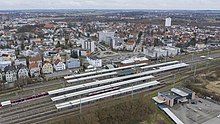Stone gate suburb
The Steintor suburb in Rostock is one of the two suburbs that emerged in the 1950s, when the city began to grow beyond its medieval walls . While the Kröpeliner-Tor-Vorstadt was primarily the residential area of the workers of the nearby shipyard, the Steintor-Vorstadt, south of the Steintor , was a residential area of the wealthy citizens.
history
The first villas in front of the city wall were built around 1850 on Neue Wallstrasse, today's Ernst-Barlach-Strasse. It was followed by Friedrich-Franz-Strasse (today August-Bebel-Strasse) and Augustenstrasse. Around 1900 the district south of it was expanded as planned. Until it was destroyed by the National Socialists in 1938 , the synagogue of the Jewish community was on Augustenstrasse.
The streets of the district were laid out relatively wide, spacious and greened by trees. Decorative squares loosen up the buildings, which are closed in the western and northern parts and are becoming more and more open to the east and south. The development consists mainly of villas and town houses, from the classicist style to historicism to art nouveau . In the southwest of the Steintor suburb are the Max-Samuel-Haus and Rostock Central Station . The area close to the city center south of the Steintor is predominantly characterized by closed and small-scale block perimeter development.
Until 1945 the streets in the north and north-west of the district were named after Rostock and Mecklenburg personalities, otherwise after battle sites, generals and politicians from the time of the Franco-German War . The main street leading to the train station was called Kaiser-Wilhelm-Straße (now Rosa-Luxemburg-Straße), Gerhart-Hauptmann-Straße was called Bismarckstraße. Since the renaming in 1945, most of the streets have been named after German poets.
Today's structure
Today the Steintor-Vorstadt is part of the Stadtmitte district and is still a quiet residential area. Lawyers, brokers, architects and engineering firms and other freelancers have also settled here. After 1990 some modern townhouses were built on vacant lots and the old buildings were often lovingly restored. In the course of the renovation of Rostock's main train station, the forecourt was completely redesigned.
The Steintor-Vorstadt is designated as a "southern urban expansion from the 2nd half of the 19th century with predominantly villa architecture from the Wilhelminian era" as a monument area. A number of buildings are listed as individual monuments on the list of monuments of the Hanseatic City of Rostock.
literature
- Jan-Peter Schulze and Hanseatic City of Rostock / Press and Information Office (ed.), Vorstadt der Bürger: Between the Steintor and the train station in Rostock : 2 vols., Rostock: Redieck & Schade, (= writings of the Rostock Cultural History Museum; New Series, Vol 16, parts 1 and 2). ISBN 978-3-942673-78-5 .
- Heinrich Trost (ed.); Gerd Baier et al. (Edit.): The architectural and art monuments in the Mecklenburg coastal region. Henschel, Berlin 1990, ISBN 3-362-00523-3 , pp. 410-422.
Web links
Individual evidence
- ↑ List of monuments of the Hanseatic City of Rostock. As of September 2016. ( Page no longer available , search in web archives ) Info: The link was automatically marked as defective. Please check the link according to the instructions and then remove this notice. (pdf; 131 kB)
Coordinates: 54 ° 4 ′ 48.7 " N , 12 ° 8 ′ 10.4" E


